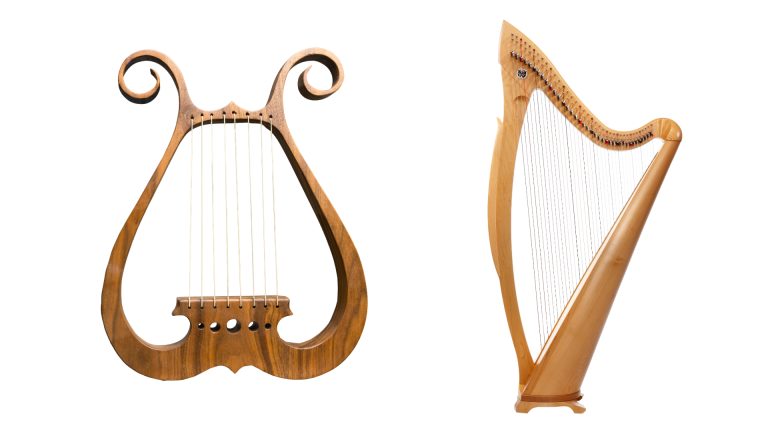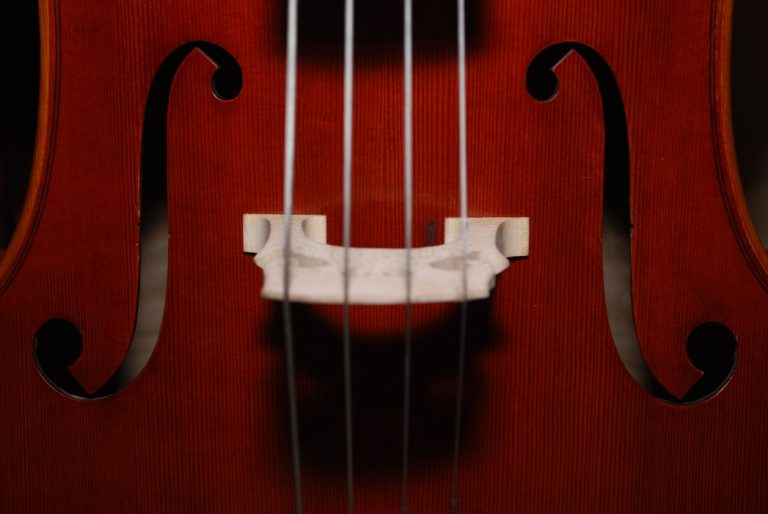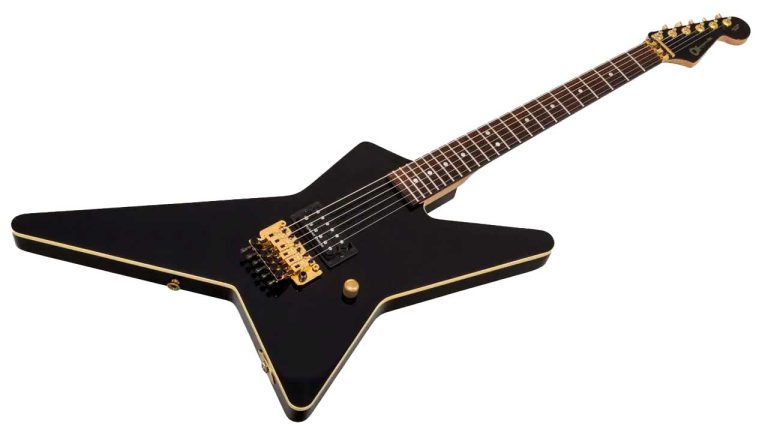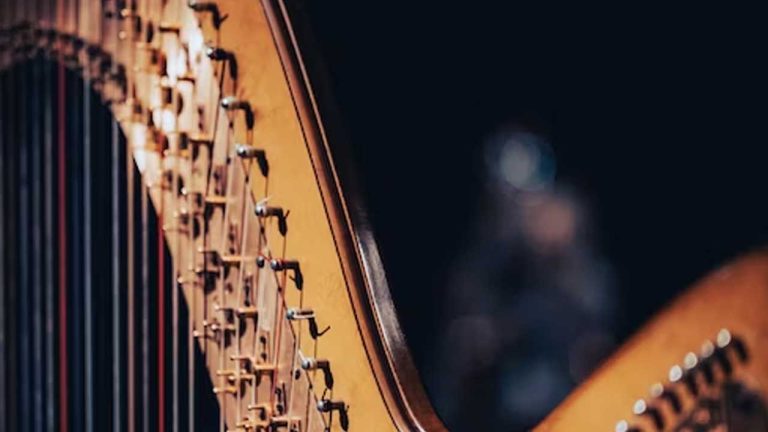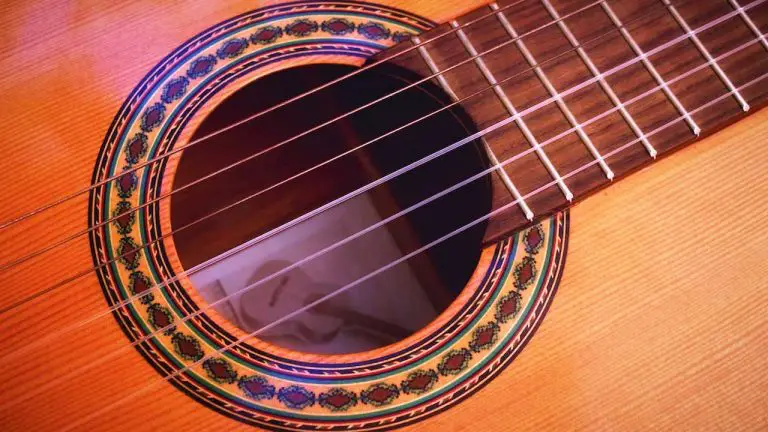Can a Guitar Sound like a Harp? Exploring Techniques and Tools
Folkstrings.com is reader-supported. When you buy through links on our site, we may earn a small commission.
The quest to replicate the ethereal sound of a harp using a guitar is a fascinating exploration for many musicians.
At first glance, these two instruments appear vastly different. The guitar is commonly associated with a wide variety of musical genres and playing styles, while the harp is often tied to classical and folk music traditions with its distinct, resonant tones.
The harp’s unique sound is produced by the plucking of strings that varies in length and tension, creating a full and richly harmonic spectrum.
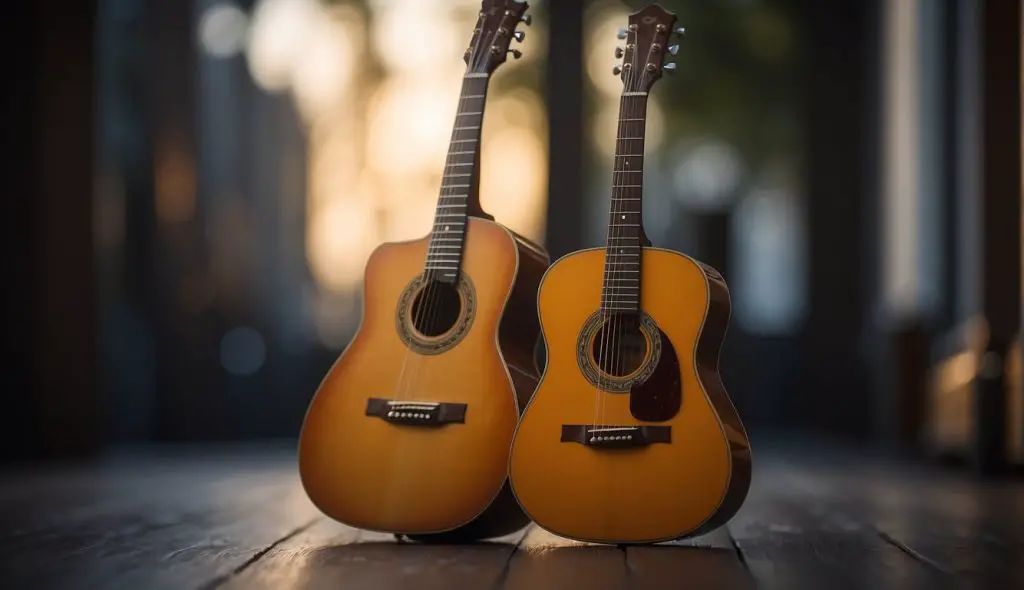
However, inventive guitar techniques can evoke a harp-like sound.
By employing certain fingerstyle techniques, guitarists can play arpeggios and harmonics that mimic the harp’s character. Isolating guitar tones and juxtaposing them with harp notes might only underscore their sonic differences to the untrained ear.
Yet with thoughtful application, a guitar can produce sounds that shimmer with a quality akin to a harp. This cross-instrument emulation enriches our understanding of the guitar’s versatility and extends its expressive capacity.
Key Points
- The guitar is adaptable and can be made to echo the resonant quality of a harp through skillful techniques.
- Guitarists use arpeggios and artificial harmonics to achieve a sound similar to that of plucked harp strings.
- Understanding the nuances of both the guitar and harp enhances a musician’s approach to creating unique soundscapes.
Table of Contents
Exploring the Guitar and Harp Soundscape
In my exploration, I aim to detail how both the guitar and the harp produce their unique sounds. I also want to show how these two instruments, which are traditionally distinct in timbre and technique, might share a soundscape.
Characteristics of Guitar Sounds
Guitars, whether acoustic or electric, have a sound defined by the vibration of their strings.
Typically, a guitar has six strings, but variations exist. The sound of a guitar is quite versatile, adapting seamlessly across various genres like rock, jazz, folk, and classical music. My experience tells me the following aspects are key:
- Tone: Achieved by the composition and gauge of the strings; steel strings offer a bright, loud tone while nylon strings provide a softer, mellower sound.
- Playing Techniques: Plucking, strumming, and fingerpicking all result in different textures. For instance, fingerpicking can mimic the gentler touch of a harp.
- Amplification: While acoustic guitars resonate via their body, electric guitars require amplifiers to enhance their sound, making them a staple in genres like rock due to their loud and clear projection.
Characteristics of Harp Sounds
Harp strings are typically plucked, giving rise to a sonorous and ethereal quality that is inherent to the harp’s identity within the classical music world.
Harp strings can be made of various materials such as gut, nylon, or metal, each contributing to the instrument’s rich palette of sounds.
- Resonance: My experience has shown that the harp has an extensive resonance given its large size and soundboard, which sustains notes longer than a guitar.
- Range of Sound: A classic concert harp boasts up to 47 strings, providing a wide range capable of deep lows and shimmering highs.
- Musical Roles: Harps frequently feature in orchestral and solo settings, often used to create mood or highlight melodic lines in a composition.
As a musician, it’s fascinating to see how both instruments, with their distinct sonic characteristics, have the potential to blend and complement each other in a shared soundscape, without one overshadowing the other.
Techniques to Mimic a Harp on Guitar
Making a guitar sound like a harp involves a mix of fingerpicking techniques, creative use of capos, alternate tunings, and sometimes the use of specialized instruments like the harp guitar.
Fingerpicking and Playing Technique
I use precise fingerpicking to mirror the delicate and fluid sound of a harp. By plucking the strings in a pattern that spans across the guitar’s neck, I can create cascading notes similar to a harp’s arpeggios.
I also practice combining both flesh and nail of my picking hand to produce a more resonant tone, much like a harpist would.
Use of Capos and Alternate Tunings
I often employ capos and alternate tunings to change the guitar’s pitch and facilitate open, ringing strings that enhance the harp-like quality.
For example, by tuning my guitar to an open chord, I allow myself to play full harmonies with a single strum, which resembles the expansive sound of a harp. Capos can be placed on different frets to mimic the change in pitch that occurs on a harp with pedals or levers.
Incorporating Harp Guitars
For a more authentic harp sound, I consider using a harp guitar. This stringed instrument combines a standard guitar with additional harp strings that are not fretted but can be plucked individually.
The extended range and ability to play bass lines, chords, and melodies simultaneously bring me much closer to the true harp experience.
The Influence of Musical Instruments and Styles
In my exploration of musical instruments, I’ve discovered the deep impact stringed instruments like the guitar and harp have on various genres, and how their evolution reflects the rich tapestry of music history.
Impact of Stringed Instruments Across Genres
My journey with stringed instruments has shown me they possess an incredible capacity to produce unique sounds that transcend genres.
The guitar, for example, can mimic a harp’s melody through a technique called the “harp sound effect”. By playing close to the fingerboard tuners, guitarists create ethereal textures reminiscent of a harp, blending the strong progress of guitar technique with the delicate joy of harp melodies.
Stringed instruments like Gibson guitars and Celtic harps have made significant contributions to musical styles. They tip-toe between robust, chordal progressions and the subtle plucks that unearth the instrument’s soul. From the intricate fingerpicking styles in folk music to searing solos in rock, my own experience echoes that stringed instruments adapt themselves to any emotion or genre.
Evolution of the Harp and Guitar in Music History
I find fascination in tracing the evolution of these elegant instruments. The harp, with its lineage dating back to ancient times, has grown from its Celtic roots into a complex instrument that continues to be invented and reinvented.
From the Italian style of the triple harp to contemporary innovations by designers like Knutson, the harp’s journey through time showcases its adaptability to various musical textures.
The guitar, not to be outshone, shares a similar story of transformation. From its classical origins to the modern Gibson electrics, the guitar has become a chameleon in the world of music. Its strings have sung the saga of history, evolving with the very fabric of musical progress. It’s a testament to the old adage that “practice makes perfect,” as each era’s musicians add their lessons to the guitar’s ongoing story.
Frequently Asked Questions
In this section, I’ll answer some common questions about achieving a harp-like sound on a guitar, including techniques and potential challenges.
How do you get the harp sound on a guitar?
To mimic the sound of a harp on a guitar, I often use techniques such as fingerpicking patterns that involve quick arpeggios, or I may use a combination of natural harmonics and open strings. This approach creates the fluid and ethereal sound characteristic of a harp.
Is it possible for harp music to be adapted for guitar?
Yes, harp music can be adapted for guitar, though some modifications may be necessary due to the differences in range and technique between the two instruments.
For example, I might condense the music and make use of the guitar’s unique capabilities while preserving the essence of the original harp composition.
Are there specific techniques to make a guitar sound more like a harp?
There are specific techniques I can use, such as the aforementioned harmonics and certain fingerpicking methods.
Additionally, I might employ the use of external devices, such as an e-bow, to sustain notes and more closely resemble the resonance of a harp.
How similar is playing the guitar compared to playing the harp?
While there are similarities in the string-based approach of playing, the guitar and harp have distinct techniques and layouts.
I find that transitioning from guitar to harp or vice versa requires an adaptation in hand positioning and a different approach to generating melodies and chords.
What are the challenges in emulating harp tones on a guitar?
A key challenge in emulating harp tones on a guitar is the difference in string resonance and sustain. I must also consider the differing number of strings and the absence of the ability to play as many simultaneous notes as a harp allows.
Does using a harp guitar make it easier to achieve harp-like sounds?
A harp guitar combines elements of both instruments. It can make it easier to achieve a harp-like sound. Its additional bass or treble strings expanded my sonic range. This allows for a closer emulation of the harp’s broad tonal palette.
Author Profile
-
Daniel Johnstone is an English writer with a love for stringed instruments from around the world.
He shares his love for these instruments through his writing for folkstrings.com, a website dedicated to all things related to folk string music.
Daniel's passion for music started at a young age, and he has since become an accomplished musician, playing guitar, cavaco, and recently, the harp.
His dedication to learning and sharing his knowledge of stringed instruments is evident in his insightful and engaging blog posts. Whether you're a seasoned musician or a beginner, Daniel's writing is sure to inspire and entertain you.
When he's not playing music or writing, you can find Daniel exploring new instruments and seeking out new sounds to share with his readers.
Latest entries
 AutoharpApril 4, 2024What Is the Autoharp Made Of: Exploring Its Materials and Craftsmanship
AutoharpApril 4, 2024What Is the Autoharp Made Of: Exploring Its Materials and Craftsmanship AutoharpApril 4, 2024Is Autoharp Easy to Play? Unveiling the Truth for Beginners
AutoharpApril 4, 2024Is Autoharp Easy to Play? Unveiling the Truth for Beginners AutoharpApril 4, 2024What Is an Autoharp Worth? Your Guide to Pricing and Value
AutoharpApril 4, 2024What Is an Autoharp Worth? Your Guide to Pricing and Value AutoharpApril 4, 2024Are Autoharp and Zither the Same Thing? Unraveling String Instrument Myths
AutoharpApril 4, 2024Are Autoharp and Zither the Same Thing? Unraveling String Instrument Myths
Affiliates:
This post may contain affiliate links that at no additional cost to you, the site may earn a small commission. We only recommend products we would use ourselves and all opinions expressed on this site are our own.
Accuracy Advice:
While we strive to provide up-to-date and accurate information, the content in this article may not reflect the most current research or medical guidelines. We encourage readers to do further research and consult with professionals for more personalized advice.
Our Recommendations:
The products and services mentioned in any of our articles are recommended based on our independent research and personal experience. We are not sponsored by any company. We aim to suggest products and services we believe are of high quality and could be beneficial to our readers.


